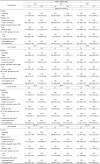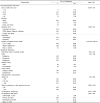1. Nordström K, Coff C, Jönsson H, Nordenfelt L, Görman U. Food and health: individual, cultural, or scientific matters? Genes Nutr. 2013; 8:357–363.

2. Grieger JA, Clifton VL. A review of the impact of dietary intakes in human pregnancy on infant birthweight. Nutrients. 2014; 7:153–178.

3. Branca F, Piwoz E, Schultink W, Sullivan LM. Nutrition and health in women, children, and adolescent girls. BMJ. 2015; 351:h4173.

4. Kattula D, Sarkar R, Sivarathinaswamy P, Velusamy V, Venugopal S, Naumova EN, Muliyil J, Ward H, Kang G. The first 1000 days of life: prenatal and postnatal risk factors for morbidity and growth in a birth cohort in southern India. BMJ Open. 2014; 4:e005404.

5. Silva-Zolezzi I, Samuel TM, Spieldenner J. Maternal nutrition: opportunities in the prevention of gestational diabetes. Nutr Rev. 2017; 75:32–50.

6. Michels KB, Schulze MB. Can dietary patterns help us detect diet-disease associations? Nutr Res Rev. 2005; 18:241–248.

7. Liu FL, Zhang YM, Parés GV, Reidy KC, Zhao WZ, Zhao A, Chen C, Ning CY, Zheng YD, Wang PY. Nutrient intakes of pregnant women and their associated factors in eight cities of china: a cross-sectional study. Chin Med J (Engl). 2015; 128:1778–1786.

8. Hu FB. Dietary pattern analysis: a new direction in nutritional epidemiology. Curr Opin Lipidol. 2002; 13:3–9.

9. Dekker LH, Nicolaou M, van Dam RM, de Vries JH, de Boer EJ, Brants HA, Beukers MH, Snijder MB, Stronks K. Socio-economic status and ethnicity are independently associated with dietary patterns: the HELIUS-dietary patterns study. Food Nutr Res. 2015; 59:26317.

10. Cespedes EM, Hu FB. Dietary patterns: from nutritional epidemiologic analysis to national guidelines. Am J Clin Nutr. 2015; 101:899–900.

11. de Seymour J, Chia A, Colega M, Jones B, McKenzie E, Shirong C, Godfrey K, Kwek K, Saw SM, Conlon C, Chong YS, Baker P, Chong MF. Maternal dietary patterns and gestational diabetes mellitus in a multi-ethnic Asian cohort: the GUSTO study. Nutrients. 2016; 8:E574.

12. Chen X, Zhao D, Mao X, Xia Y, Baker PN, Zhang H. Maternal dietary patterns and pregnancy outcome. Nutrients. 2016; 8:E351.

13. Tryggvadottir EA, Medek H, Birgisdottir BE, Geirsson RT, Gunnarsdottir I. Association between healthy maternal dietary pattern and risk for gestational diabetes mellitus. Eur J Clin Nutr. 2016; 70:237–242.

14. Lu MS, He JR, Chen Q, Lu J, Wei X, Zhou Q, Chan F, Zhang L, Chen N, Qiu L, Yuan M, Cheng KK, Xia H, Qiu X. Born in Guangzhou Cohort Study Group. Maternal dietary patterns during pregnancy and preterm delivery: a large prospective cohort study in China. Nutr J. 2018; 17:71.

15. Englund-Ögge L, Brantsæter AL, Sengpiel V, Haugen M, Birgisdottir BE, Myhre R, Meltzer HM, Jacobsson B. Maternal dietary patterns and preterm delivery: results from large prospective cohort study. BMJ. 2014; 348:g1446.

16. Martin CL, Siega-Riz AM, Sotres-Alvarez D, Robinson WR, Daniels JL, Perrin EM, Stuebe AM. Maternal dietary patterns during pregnancy are associated with child growth in the first 3 years of life. J Nutr. 2016; 146:2281–2288.

17. Chia AR, de Seymour JV, Colega M, Chen LW, Chan YH, Aris IM, Tint MT, Quah PL, Godfrey KM, Yap F, Saw SM, Baker PN, Chong YS, van Dam RM, Lee YS, Chong MF. A vegetable, fruit, and white rice dietary pattern during pregnancy is associated with a lower risk of preterm birth and larger birth size in a multiethnic Asian cohort: the growing up in Singapore towards healthy outcomes (GUSTO) cohort study. Am J Clin Nutr. 2016; 104:1416–1423.

18. Grieger JA, Grzeskowiak LE, Clifton VL. Preconception dietary patterns in human pregnancies are associated with preterm delivery. J Nutr. 2014; 144:1075–1080.

19. Hajianfar H, Esmaillzadeh A, Feizi A, Shahshahan Z, Azadbakht L. Major maternal dietary patterns during early pregnancy and their association with neonatal anthropometric measurement. BioMed Res Int. 2018; 2018:4692193.

20. Okubo H, Miyake Y, Sasaki S, Tanaka K, Murakami K, Hirota Y, Kanzaki H, Kitada M, Horikoshi Y, Ishiko O, Nakai Y, Nishio J, Yamamasu S, Yasuda J, Kawai S, Yanagihara K, Wakuda K, Kawashima T, Narimoto K, Iwasa Y, Orino K, Tsunetoh I, Yoshida J, Iito J, Kaneko T, Kamiya T, Kuribayashi H, Taniguchi T, Takemura H, Morimoto Y, Matsunaga I, Oda H, Ohya Y. Osaka Maternal and Child Health Study Group. Maternal dietary patterns in pregnancy and fetal growth in Japan: the Osaka maternal and child health study. Br J Nutr. 2012; 107:1526–1533.

21. Murrin C, Shrivastava A, Kelleher CC. Lifeways Cross-generation Cohort Study Steering Group. Maternal macronutrient intake during pregnancy and 5 years postpartum and associations with child weight status aged five. Eur J Clin Nutr. 2013; 67:670–679.

22. Chen LW, Aris IM, Bernard JY, Tint MT, Colega M, Gluckman PD, Tan KH, Shek LP, Chong YS, Yap F, Godfrey KM, van Dam RM, Chong MF, Lee YS. Associations of maternal macronutrient intake during pregnancy with infant BMI peak characteristics and childhood BMI. Am J Clin Nutr. 2017; 105:705–713.

23. Wood-Bradley RJ, Henry SL, Vrselja A, Newman V, Armitage JA. Maternal dietary intake during pregnancy has longstanding consequences for the health of her offspring. Can J Physiol Pharmacol. 2013; 91:412–420.

24. Chatzi L, Torrent M, Romieu I, Garcia-Esteban R, Ferrer C, Vioque J, Kogevinas M, Sunyer J. Mediterranean diet in pregnancy is protective for wheeze and atopy in childhood. Thorax. 2008; 63:507–513.

25. Willers SM, Devereux G, Craig LC, McNeill G, Wijga AH, Abou El-Magd W, Turner SW, Helms PJ, Seaton A. Maternal food consumption during pregnancy and asthma, respiratory and atopic symptoms in 5-year-old children. Thorax. 2007; 62:773–779.

26. Jarman M, Mathe N, Ramazani F, Pakseresht M, Robson PJ, Johnson ST, Bell RC. APrON and ENRICH study teams. Dietary patterns prior to pregnancy and associations with pregnancy complications. Nutrients. 2018; 10:E914.

27. Zareei S, Homayounfar R, Naghizadeh MM, Ehrampoush E, Rahimi M. Dietary pattern in pregnancy and risk of gestational diabetes mellitus (GDM). Diabetes Metab Syndr. 2018; 12:399–404.

28. Rasmussen MA, Maslova E, Halldorsson TI, Olsen SF. Characterization of dietary patterns in the Danish national birth cohort in relation to preterm birth. PLoS One. 2014; 9:e93644.

29. Da Mota Santana J, Alves de Oliveira Queiroz V, Monteiro Brito S, Barbosa Dos Santos D, Marlucia Oliveira Assis A. Food consumption patterns during pregnancy: a longitudinal study in a region of the North East of Brazil. Nutr Hosp. 2015; 32:130–138.
30. Bao W, Bowers K, Tobias DK, Hu FB, Zhang C. Prepregnancy dietary protein intake, major dietary protein sources, and the risk of gestational diabetes mellitus: a prospective cohort study. Diabetes Care. 2013; 36:2001–2008.

31. Schoenaker DA, Soedamah-Muthu SS, Callaway LK, Mishra GD. Pre-pregnancy dietary patterns and risk of gestational diabetes mellitus: results from an Australian population-based prospective cohort study. Diabetologia. 2015; 58:2726–2735.

32. Yang J, Dang S, Cheng Y, Qiu H, Mi B, Jiang Y, Qu P, Zeng L, Wang Q, Li Q, Kang Y, Shen Y, Yan H. Dietary intakes and dietary patterns among pregnant women in Northwest China. Public Health Nutr. 2017; 20:282–293.

33. He JR, Yuan MY, Chen NN, Lu JH, Hu CY, Mai WB, Zhang RF, Pan YH, Qiu L, Wu YF, Xiao WQ, Liu Y, Xia HM, Qiu X. Maternal dietary patterns and gestational diabetes mellitus: a large prospective cohort study in China. Br J Nutr. 2015; 113:1292–1300.

34. Yong HY, Mohd Shariff Z, Rejali Z, Mohd Yusof BN, Yasmin F, Palaniveloo L. Seremban cohort study (SECOST): a prospective study of determinants and pregnancy outcomes of maternal glycaemia in Malaysia. BMJ Open. 2018; 8:e018321.

35. Ministry of Health Malaysia. Malaysian Adult Nutrition Survey 2003. Putrajaya: Nutrition Section Family Health Development Division Ministry of Health Malaysia;2007.
36. Loy SL, Marhazlina M, Nor AY, Hamid JJ. Development, validity and reproducibility of a food frequency questionnaire in pregnancy for the Universiti Sains Malaysia birth cohort study. Malays J Nutr. 2011; 17:1–18.
37. Norimah AK, Safiah M, Jamal K, Haslinda S, Zuhaida H, Rohida S, Fatimah S, Norazlin S, Poh BK, Kandiah M, Zalilah MS, Wan Manan WM, Fatimah S, Azmi MY. Food consumption patterns: findings from the Malaysian adult nutrition survey (MANS). Malays J Nutr. 2008; 14:25–39.
38. Nurliyana AR, Mohd Nasir MT, Zalilah MS, Rohani A. Dietary patterns and cognitive ability among 12- to 13 year-old adolescents in Selangor, Malaysia. Public Health Nutr. 2015; 18:303–312.

39. Shadman Z, Poorsoltan N, Akhoundan M, Larijani B, Soleymanzadeh M, Akhgar Zhand C, Seyed Rohani ZA, Khoshniat Nikoo M. Ramadan major dietary patterns. Iran Red Crescent Med J. 2014; 16:e16801.

40. Marchioni DM, Latorre Mdo R, Eluf-Neto J, Wünsch-Filho V, Fisberg RM. Identification of dietary patterns using factor analysis in an epidemiological study in São Paulo. Sao Paulo Med J. 2005; 123:124–127.

41. Hu FB, Rimm E, Smith-Warner SA, Feskanich D, Stampfer MJ, Ascherio A, Sampson L, Willett WC. Reproducibility and validity of dietary patterns assessed with a food-frequency questionnaire. Am J Clin Nutr. 1999; 69:243–249.

42. Nishida C, Ko GT, Kumanyika S. Body fat distribution and noncommunicable diseases in populations: overview of the 2008 WHO expert consultation on waist circumference and waist-hip ratio. Eur J Clin Nutr. 2010; 64:2–5.

43. Obesity: preventing and managing the global epidemic. Report of a WHO consultation. World Health Organ Tech Rep Ser. 2000; 894:i–xii. 1–253.
44. IBM Corp. Released. IBM SPSS Statistics for Windows, Version 23.0. Armonk (NY): IBM Corp.;2015.
45. Greenland S. Modeling and variable selection in epidemiologic analysis. Am J Public Health. 1989; 79:340–349.

46. Hosmer DW, Lemeshow S. Applied logistic regression. In : Shewhart WA, Wilks SS, editors. Model-Building Strategies and Methods for Logistic Regression. Hoboken (NJ): John Wiley & Sons, Inc.;2000. p. 91–142.
47. Bao W, Bowers K, Tobias DK, Olsen SF, Chavarro J, Vaag A, Kiely M, Zhang C. Prepregnancy low-carbohydrate dietary pattern and risk of gestational diabetes mellitus: a prospective cohort study. Am J Clin Nutr. 2014; 99:1378–1384.

48. Loy SL, Marhazlina M, Jan JM. Association between maternal food group intake and birth size. Sains Malays. 2013; 42:1633–1640.
49. Shin D, Lee KW, Song WO. Dietary patterns during pregnancy are associated with risk of gestational diabetes mellitus. Nutrients. 2015; 7:9369–9382.

50. Baik I, Lee M, Jun NR, Lee JY, Shin C. A healthy dietary pattern consisting of a variety of food choices is inversely associated with the development of metabolic syndrome. Nutr Res Pract. 2013; 7:233–241.

51. Cox JT, Phelan ST. Nutrition during pregnancy. Obstet Gynecol Clin North Am. 2008; 35:369–383.

52. De-Graft Aikins A. Food beliefs and practices during pregnancy in Ghana: implications for maternal health interventions. Health Care Women Int. 2014; 35:954–972.

53. Yong HY, Mohd Shariff Z, Koo SJ, Binti Sa'ari NS. Pre-pregnancy body mass index, height and physical activity are associated with rate of gestational weight gain among Malaysian mothers. J Obstet Gynaecol Res. 2016; 42:1094–1101.

54. Kramer MS, Kakuma R. Energy and protein intake in pregnancy. Cochrane Database Syst Rev. 2003; CD000032.

55. Loy SL, Jan Mohamed HJ. Relative validity of dietary patterns during pregnancy assessed with a food frequency questionnaire. Int J Food Sci Nutr. 2013; 64:668–673.

56. Manaf ZA, Johari N, Mei LY, Yee NS, Yin CK, Teng LW. Nutritional status and nutritional knowledge of Malay pregnant women in selected private hospitals in Klang Valley. J Sains Kesihat Malays. 2014; 12:53–62.

57. Lim ZX, Wong JL, Lim PY. Knowledge of nutrition during pregnancy and associated factors among antenatal mothers. Int J Publ Health Clin Sci. 2018; 5:117–128.
58. Lanfer A, Knof K, Barba G, Veidebaum T, Papoutsou S, de Henauw S, Soós T, Moreno LA, Ahrens W, Lissner L. Taste preferences in association with dietary habits and weight status in European children: results from the IDEFICS study. Int J Obes (Lond). 2012; 36:27–34.

59. Stelmach-Mardas M, Rodacki T, Dobrowolska-Iwanek J, Brzozowska A, Walkowiak J, Wojtanowska-Krosniak A, Zagrodzki P, Bechthold A, Mardas M, Boeing H. Link between food energy density and body weight changes in obese adults. Nutrients. 2016; 8:229.






 PDF
PDF ePub
ePub Citation
Citation Print
Print





 XML Download
XML Download